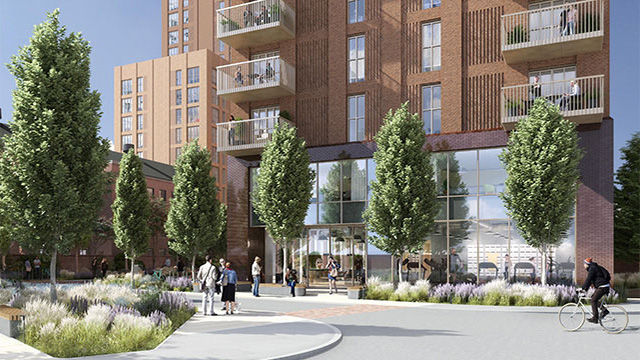The appeal of an auction to an investor is obvious, especially in economically sticky times such as now. You stand a chance of buying at below market value and the property is yours quickly – within 28 days of the auction date, by which time you have to pay for it.
That “paying for it” part presents investors with a wide range of options.
“I would estimate that 25-35% of auction bidders are private buyers. The rest are professionals. The former will generally require property-specific finance. The professionals will either be buying with cash or, more likely, have a general loan facility,” says Gary Murphy, partner and auctioneer at Allsops.
These options can sound intimidating to the first-time or inexperienced investor, few of whom will have sufficient disposable cash to pay outright for even a modest commercial, mixed-use or residential property. However, expert advice is close at hand.
So how do you go about finding funding and what options are available?
Mortgage broker
An obvious first step is a mortgage broker, who will know the most appropriate kind of funding for your auction aspirations.
Some brokers operate “whole market” while some select options only from a panel of providers; in addition, some lenders deal only with borrowers directly and not with brokers at all.
Even so, a broker is most likely to offer the advice you will need as you dip your toe in the auction investment market.
The brave can come to the auction with the deposit ready should the bid be successful, and negotiate with the favoured lenders linked with each auction house. There are usually loan experts at hand at each major auction these days but this route obviously means you do not have an opportunity to trawl the market for the optimum product and lender.
However you find your loans expert, he or she is likely to talk you through four key options.
Firstly there are commercial investment mortgages, which are likely to be used if you buy a retail unit, office or other commercial property. These mortgages are individually priced to match each proposal. Are you going to let out the property? Sell it for capital appreciation? Refurb and then let or sell? Terms will depend on your business record and proposals.
Most commercial mortgages are variable rate, moving in line with Bank of England base rate, and typically have a maximum loan to value of 75%.
Buy-to-let mortgages
Secondly there are buy-to-let mortgages.
BTL is defined as a business, so rates and fees on these mortgages are higher than on an owner-occupier’s residential mortgage.
The largest loan-to-value is usually 85% and so-called portfolio landlords and most lenders regard whole blocks of flats, homes in multiple occupation and ingle residential units as potentially eligible for buy-to-let mortgages.
Some high street banks still lend on BTL but in response to Bank of England guidelines, most lenders have tightened their criteria, especially for so-called portfolio landlords with four or more residential properties to let.
“Buy to let has been the subject of repeated fiscal and regulatory intervention in recent times. What we are seeing emerge is a more specialist market with a marked increase in more complex, professional landlord business,” says John Heron, director of Paragon Mortgages, one of the largest niche lenders serving this sector.
Auction finance
The third option is auction finance.
This is a short-term loan delivered in good time to meet auction deadlines – after you pay a 10% deposit when you buy, the remaining 90% must be paid within 28 days.
Auction finance specialists are often present at auctions although it is sensible to have provisional approval for a loan before you bid.
“The lender will need evidence of a clear and viable repayment strategy, such as the sale of the property or refinance to a more traditional mortgage,” says Mark Harris of SPF Private Clients, a brokerage with expertise in securing funding for auction purchases.
Scott Hendry, director at Together, a specialist lender that works with SDL, a major auction house, says mainstream lenders rarely work quickly enough to meet auction deadlines.
“A significant advantage we bring is our ability to secure funding prior to the day. Those interested in a property but unsure of what they can borrow can apply to us and receive an offer in principle. When it comes to bidding, they know what they can spend.”
Bridging loans
Fourthly, there are bridging loans.
These are short-term loans secured against residential or commercial property and are a popular choice for funding refurbishment work before a sale.
Rates are typically high and usually individually determined based on project duration, borrower history and the scale of the proposed work.
Like auction finance, this is usually replaced within a short time by a longer-term mortgage. For example, Bridging Financial Solutions, which works with some regional auctioneers, offers loans of between one and 12 months with the expectation they are then replaced by longer-term mortgages.
So for investors, funding choices are varied, but making the correct decision is vital, because competition at almost all residential and commercial auctions in 2017 has been strong.
“There’s a lot of uncertainty in the world at present, but one certainty remains,” says James Emson of auctioneer Clive Emson. “That is, there’s security in bricks and mortar.”
Getting funding right makes that security all the greater.
How to avoid pitfalls
■ Get in quick with a survey: “You have only the time between the catalogue being published and the auction taking place – usually three weeks – to do due diligence, placing pressure on bidders,” says Richard Adamson, partner and auctioneer at Allsop.
■ Budget for due diligence: The legal work and surveys before making a bid can cost literally thousands, especially on multiple properties when you might bid successfully on only one – or maybe none at all.
■ Get your total borrowing right: “It’s important to remember that the guide prices quoted are just that. They are an indication of the seller’s lowest expectations, not an estimate of the likely sale price,” says Adamson.
■ Always check the so-called Important Notice to Bidders and the Memorandum of Sale for the auction you attend; try to see the legal pack for the lot you are interested in (this contains documents such as the title information, searches and leasehold documents) and also discover if there are any special conditions of sale.
The four-stage auction process
First, do your research. Decide what property type you want and analyse catalogues for the next appropriate auctions at which your chosen type will be sold. From that, calculate the likely cost of your choice and decide how much of your existing funds you wish to commit.
Second, seek provisional approval from a lender familiar with auction time scales and processes.
The details you will be required to give such a lender will depend on your chosen investment, your own funds, investment history and improvement plans for your purchased property. But in most cases, expect to undergo personal credit checks and have both a professional valuation and survey undertaken on the property you want.
Third, with provisional approval comes useful information.
Say you are buying a shop with flat above, and it’s your first investment. You may get 80% funding for the expected £200,000 price the property will fetch, so that’s £160,000. From this you know you must find the other 20% (£40,000) and you have an upper limit. You now know that if you bid beyond this, you must find the additional funding from another source.
Finally, remember that if you succeed at the auction, you put down a 10% deposit that day and from then you typically have 28 days to pay the balance, or you lose your deposit.
The short-term loan landscape
Although short-term loans are not undertaken solely for auction purchases, the rise in business across this lending sector suggests more interest in this kind of investment, according to the Association of Short Term Lenders.
ASTL data shows a 9.4% growth in such loans to £2.8bn in 2016, against £2.6bn in 2015. In the final quarter of 2016 such loans really took off – the total borrowed was 26% higher than in the same period the previous year.










